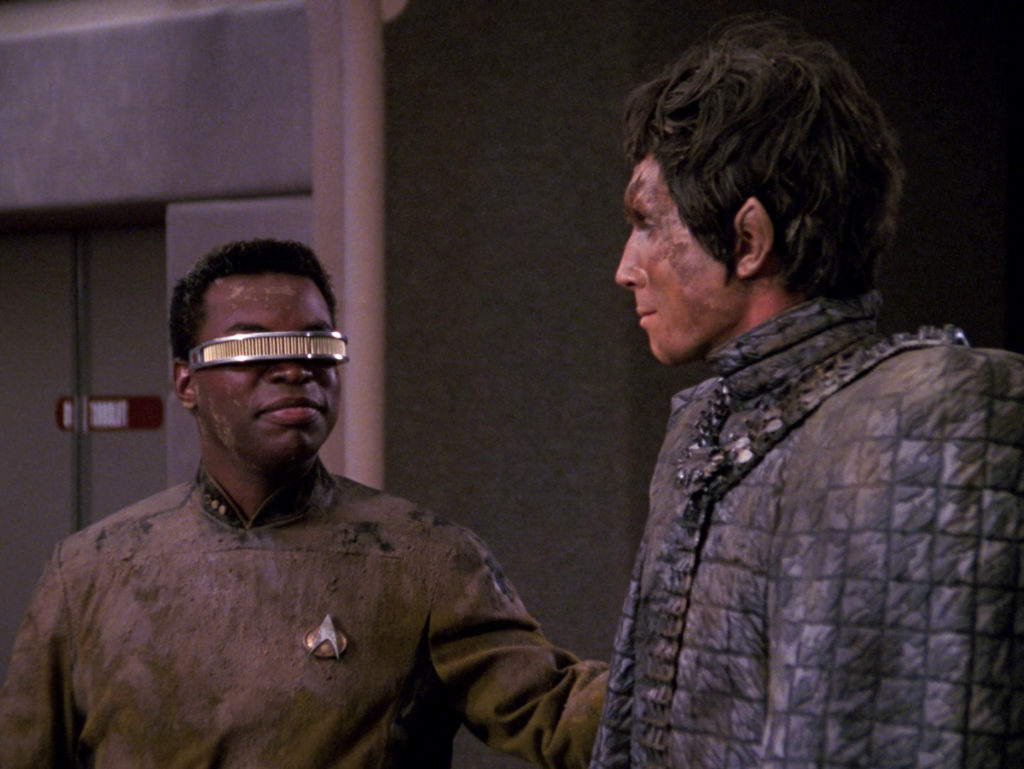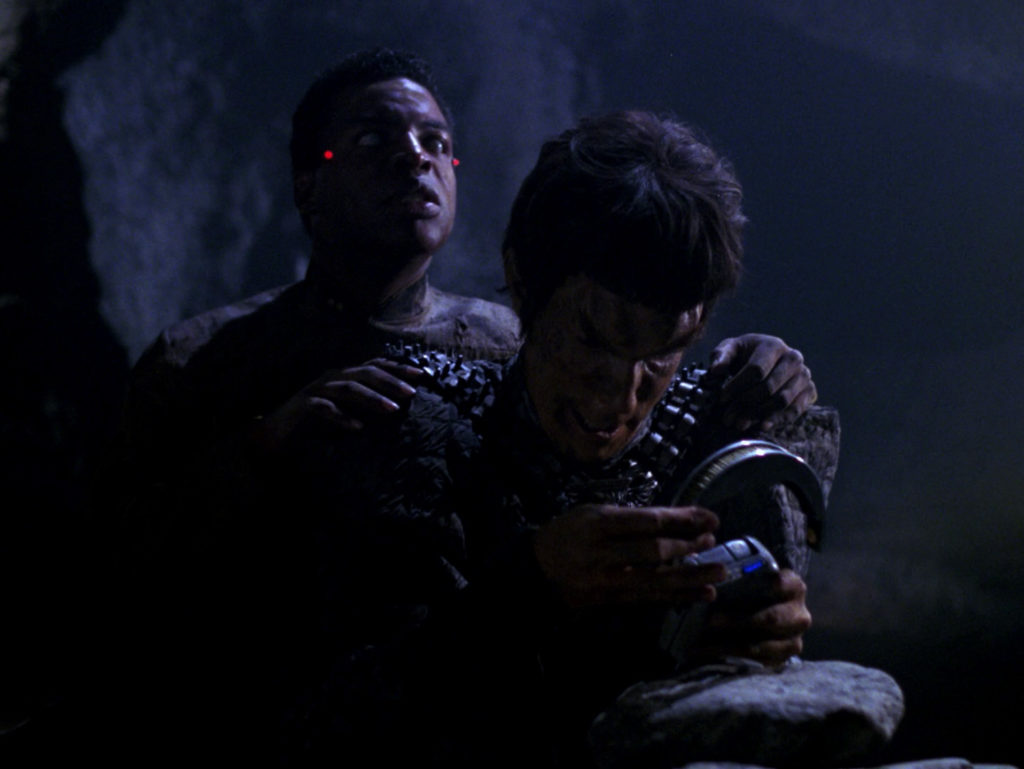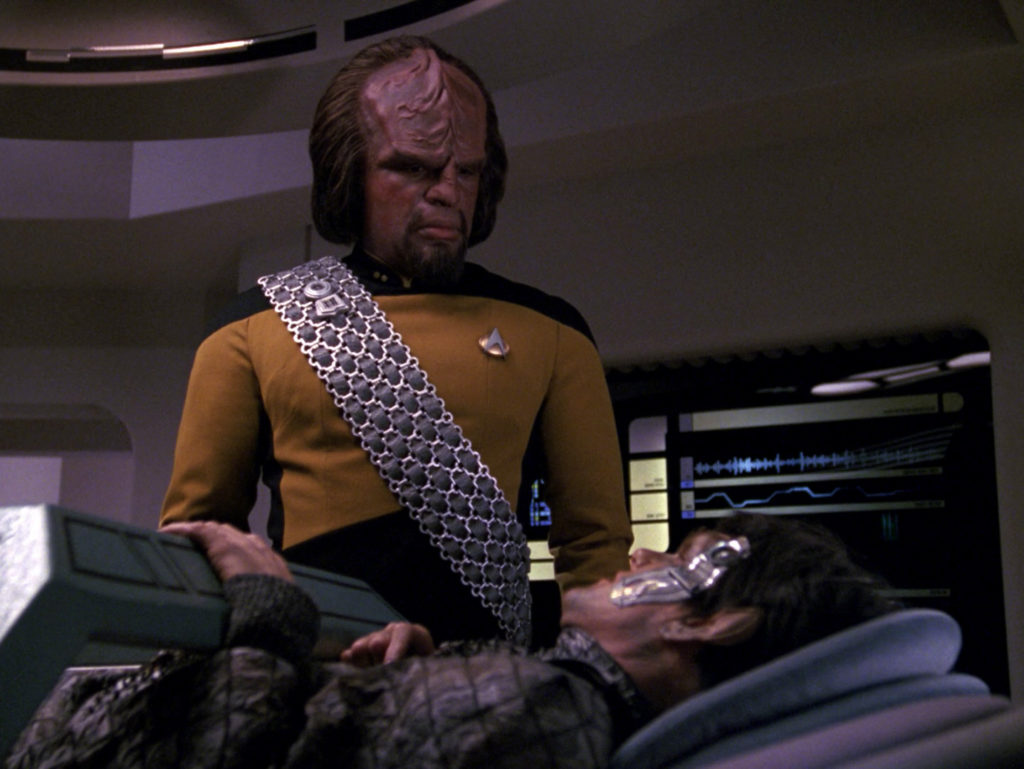 On the surface, the season three TNG episode entitled “The Enemy,” is clearly an allegory of Cold War era Soviet-US American diplomacy. The overarching plot is about an attempt to prevent war between the Federation and the Romulans, and Captain Picard’s patented call to action speech in the final minutes of the episode explicitly addresses the need for responsible leaders to deescalate conflicts. However, I want to examine the main thrust of the episode, which has Geordi stranded on the planet below, with only a single marooned Romulan, “commodore” Centurion Bochra, to aid in his escape. This narrative points to an even greater lesson about cooperation and prejudice reduction—greater, in part, because this is one of the rare instances where Star Trek engages with non-therapeutic psychological science: In this case, intergroup contact theory.
On the surface, the season three TNG episode entitled “The Enemy,” is clearly an allegory of Cold War era Soviet-US American diplomacy. The overarching plot is about an attempt to prevent war between the Federation and the Romulans, and Captain Picard’s patented call to action speech in the final minutes of the episode explicitly addresses the need for responsible leaders to deescalate conflicts. However, I want to examine the main thrust of the episode, which has Geordi stranded on the planet below, with only a single marooned Romulan, “commodore” Centurion Bochra, to aid in his escape. This narrative points to an even greater lesson about cooperation and prejudice reduction—greater, in part, because this is one of the rare instances where Star Trek engages with non-therapeutic psychological science: In this case, intergroup contact theory.
Originating in the push towards integration during the late 1940s and ‘50s in the United States, intergroup contact theory, or the theory that contact between members of different social groups can reduce prejudice, has evolved into one of the best researched theories of prejudice reduction in scientific literature, both in quality and in quantity. This is in part because cross-group contact is easily tested experimentally, unlike other methods of prejudice reduction. Since Gordon Allport’s highly influential 1954 work, The Nature of Prejudice, research has tended to focus on four key factors for optimal intergroup contact.
The first is that contact should be between those of relatively equal status within the interaction. In the “The Enemy,” Geordi and Bochra are both officers, though it is unclear who is actually of higher rank; Memory Alpha references a lost joke that suggests that the rank of centurion was higher than Geordi’s. Second, there is a need for a common goal. While Bochra talks a good game about being willing to die on the planet rather than risk being taken alive by the Federation, eventually, he is convinced by Geordi (and presumably his own self-interest) to measure the value of his life against this sacrifice. This leads to the third factor—intergroup cooperation. In “the first Federation/Romulan co-venture” (“The Enemy,” 34:17), Bochra and Geordi work together to modify Geordi’s VISOR so they can find the neutrino beacon that will lead to their rescue.

In “the first Federation-Romulan coventure,” Bochra recalibrates Geordi’s tricorder to interface with his VISOR. Bochra is crouched in the foreground and Geordi stands behind him, giving instructions with his hands on Bochra’s shoulders.
However, the last of Allport’s conditions is not as easily identifiable: institutional support. Evidence for this in our example is murky, as the underpinnings of Bochra and Geordi’s respective trainings are clearly at cross purposes. It can be assumed by the number of times Bochra continues to exert dominance over an increasingly exacerbated Geordi, that the Romulan playbook is very different from Starfleet’s in a time of crisis. Still, there is a general desire to prevent all out war in any Romulan-centric episode. Interestingly, this ambivalence again reinforces the research. While Allport’s original conditions can be seen as helpful, they are not actually necessary for intergroup contact to work.
In “Recent Advances in Intergroup Contact Theory,” psychologists Pettigrew, Tropp, Wagner, and Christ rigorously evaluate a large swath of published and unpublished studies from over sixty years of intergroup contact research. They found that in more than 500 studies and in multiple cultures, contact consistently reduces prejudice, and not only racism, but also other forms of prejudice like homophobia and ablism. Though Allport’s original conditions were associated, statistically speaking, with prejudice reduction, contact itself led to a decrease in prejudice regardless. The researchers also discussed the importance of cross-group friendships (ironically, having that one Romulan friend may actually be beneficial, if it is indeed friendship not tokenism), as well as the impact of negative contact experiences.
Unsurprisingly, researchers have found that negative contact leads to increased prejudice, and is more likely to occur when participants feel threatened, and/or do not choose to be in the contact situation—something that is typified by Worf’s experiences in “The Enemy.” Worf purposefully avoids interactions with the Romulan brought on board to receive medical treatment, Patahk, but when Worf is discovered to be the only person who can save Patahk’s life through a donation of ribosomes, he is forced to grapple with the situation head-on.

There does not seem to be a lot of hope textually for this contact experience, and it is only reinforced when analyzed with Allport’s four characteristics. Even though there is nothing but institutional support for the two to get along, both Worf and Patahk have almost zero ability to communicate productively, in part because of their incredibly large power imbalance and complete lack of motivation to cooperate. This is in no doubt exacerbated by Patahk’s extreme racism and Worf’s personal biases, stemming directly from his parents’ murder by Romulans at Khitomer.
In turn, this brings us to one of the more sound criticisms leveled at intergroup contact theory, at least according to Pettigrew and company: If you can’t actually be in a room with someone without entering into physical violence or other abusive contact, how are you supposed to have “humanizing” interactions? Can we really expect mere exposure to reduce the prejudice of someone who would write off an entire species, or a person that is racist enough to turn down life-saving medical treatment? Clearly, there are limits to what individual intergroup contact can be expected to achieve.
Even so, it is likely that, in a less serialized version of events, Geordi and Bochra would have come away from the events of “The Enemy” with less prejudice. Unfortunately, unlike the notable relationship of L’Rell and Admiral Cornwell in Discovery, Geordi is not given the opportunity to demonstrate this elsewhere in the series and Bochra is never to be heard from again. That being said, this episode is one of the clearest illustrations of intergroup contact the franchise has to offer. Unlike other scientific disciplines, and despite having a trained psychologist onboard, the writers of TNG, and Star Trek in general, rarely cover psychological research. It is therefore even more important to note where social science slips in, even if it’s an episode that’s ostensibly about something else.